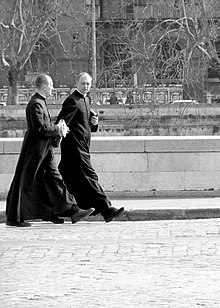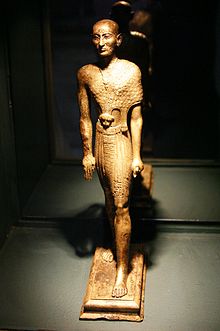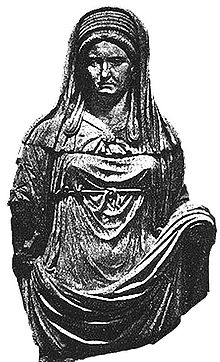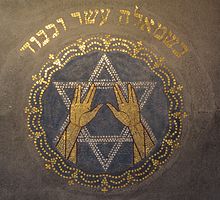Priest



A priest is a religious leader authorized to perform the sacred rituals of a religion, especially as a mediatory agent between humans and one or more deities. They also have the authority or power to administer religious rites; in particular, rites of sacrifice to, and propitiation of, a deity or deities. Their office or position is the priesthood, a term which also may apply to such persons collectively. A priest may have the duty to hear confessions periodically, give marriage counseling, provide prenuptial counseling, give spiritual direction, teach catechism, or visit those confined indoors, such as the sick in hospitals and nursing homes.
Description[]
According to the trifunctional hypothesis of prehistoric Proto-Indo-European society, priests have existed since the earliest of times and in the simplest societies, most likely as a result of agricultural surplus and consequent social stratification.[citation needed] The necessity to read sacred texts and keep temple or church records helped foster literacy in many early societies. Priests exist in many religions today, such as all or some branches of Judaism, Christianity, Buddhism, Shinto and Hinduism. They are generally regarded as having privileged contact with the deity or deities of the religion to which they subscribe, often interpreting the meaning of events and performing the rituals of the religion. There is no common definition of the duties of priesthood between faiths; but generally it includes mediating the relationship between one's congregation, worshippers, and other members of the religious body, and its deity or deities, and administering religious rituals and rites. These often include blessing worshipers with prayers of joy at marriages, after a birth, and at consecrations, teaching the wisdom and dogma of the faith at any regular worship service, and mediating and easing the experience of grief and death at funerals – maintaining a spiritual connection to the afterlife in faiths where such a concept exists. Administering religious building grounds and office affairs and papers, including any religious library or collection of sacred texts, is also commonly a responsibility – for example, the modern term for clerical duties in a secular office refers originally to the duties of a cleric. The question of which religions have a "priest" depends on how the titles of leaders are used or translated into English. In some cases, leaders are more like those that other believers will often turn to for advice on spiritual matters, and less of a "person authorized to perform the sacred rituals." For example, clergy in Roman Catholicism and Eastern Orthodoxy are priests, as with certain synods of Lutheranism and Anglicanism, though other branches of Protestant Christianity, such as Methodists and Baptists, use minister and pastor. The terms priest and priestess are sufficiently generic that they may be used in an anthropological sense to describe the religious mediators of an unknown or otherwise unspecified religion.
In many religions, being a priest or priestess is a full-time position, ruling out any other career. Many Christian priests and pastors choose or are mandated to dedicate themselves to their churches and receive their living directly from their churches. In other cases, it is a part-time role. For example, in the early history of Iceland the chieftains were titled goði, a word meaning "priest". As seen in the saga of Hrafnkell Freysgoði, however, being a priest consisted merely of offering periodic sacrifices to the Norse gods and goddesses; it was not a full-time role, nor did it involve ordination.
In some religions, being a priest or priestess is by human election or human choice. In Judaism, the priesthood is inherited in familial lines. In a theocracy, a society is governed by its priesthood.
Etymology[]
The word "priest", is ultimately derived from Latin via Greek presbyter,[1] the term for "elder", especially elders of Jewish or Christian communities in late antiquity. The Latin presbyter ultimately represents Greek πρεσβύτερος presbúteros, the regular Latin word for "priest" being sacerdos, corresponding to ἱερεύς hiereús.
It is possible that the Latin word was loaned into Old English, and only from Old English reached other Germanic languages via the Anglo-Saxon mission to the continent, giving Old Icelandic prestr, Old Swedish präster, Old High German priast. Old High German also has the disyllabic priester, priestar, apparently derived from Latin independently via Old French presbtre.
Αn alternative theory makes priest cognate with Old High German priast, prest, from Vulgar Latin *prevost "one put over others", from Latin praepositus "person placed in charge".[2]
That English should have only the single term priest to translate presbyter and sacerdos came to be seen as a problem in English Bible translations. The presbyter is the minister who both presides and instructs a Christian congregation, while the sacerdos, offerer of sacrifices, or in a Christian context the eucharist, performs "mediatorial offices between God and man".[3]
The feminine English noun, priestess, was coined in the 17th century, to refer to female priests of the pre-Christian religions of classical antiquity. In the 20th century, the word was used in controversies surrounding the women ordained in the Anglican communion, who are referred to as "priests", irrespective of gender, and the term priestess is generally considered archaic in Christianity.
Historical religions[]

In historical polytheism, a priest administers the sacrifice to a deity, often in highly elaborate ritual. In the Ancient Near East, the priesthood also acted on behalf of the deities in managing their property.
Priestesses in antiquity often performed sacred prostitution, and in Ancient Greece, some priestesses such as Pythia, priestess at Delphi, acted as oracles.
Ancient priests and priestesses[]
- Sumerian en (Akkadian: entu) were top-ranking priestesses who were distinguished with special ceremonial attire and held equal status to high priests. They owned property, transacted business, and initiated the hieros gamos with priests and kings.[4]
- Enheduanna (2285–2250 BCE) was the first known holder of the title en.
- Nadītu served as priestesses in the temples of Inanna in the city of Uruk. They were recruited from the highest families in the land and were supposed to remain childless, owned property, and transacted business.
- The Sumerian word nin, EREŠ in Akkadian, is the sign for "lady." nin.dingir (Akkadian entu), literally "divine lady", a priestess.
- In Sumerian epic texts such as "Enmerkar and the Lord of Aratta", nu-gig were priestesses in temples dedicated to Inanna and may be a reference to the goddess herself.[5]
- Puabi of Ur was an Akkadian queen regnant or a priestess. In several other Sumerian city-states, the ruling governor or king was also a head priest with the rank of ensi, such as at Lagash.
- Control of the holy city of Nippur and its temple priesthood generally meant hegemony over most of Sumer, as listed on the Sumerian King List; at one point, the Nippur priesthood conferred the title of queen of Sumer on Kugbau, a popular taverness from nearby Kish (who was later deified as Kubaba).
- In the Hebrew Bible, Hebrew: קְדֵשָׁה qědēšā,[6] derived from the root Q-D-Š[7] were sacred prostitutes usually associated with the goddess Asherah.
- Quadishtu served in the temples of the Sumerian goddess Qetesh.
- Ishtaritu specialized in the arts of dancing, music, and singing and they served in the temples of Ishtar.[8]
- In the Epic of Gilgamesh, priestess Shamhat, a temple prostitute, tamed wild Enkidu after "six days and seven nights."
- Gerarai, fourteen Athenian matrons of Dionysus, presided over sacrifices and participated in the festivals of Anthesteria.
Ancient Egypt[]
In ancient Egyptian religion, the right and obligation to interact with the gods belonged to the pharaoh. He delegated this duty to priests, who were effectively bureaucrats authorized to act on his behalf. Priests staffed temples throughout Egypt, giving offerings to the cult images in which the gods were believed to take up residence and performing other rituals for their benefit.[9] Little is known about what training may have been required of priests, and the selection of personnel for positions was affected by a tangled set of traditions, although the pharaoh had the final say. In the New Kingdom of Egypt, when temples owned great estates, the high priests of the most important cult—that of Amun at Karnak—were important political figures.[10]
High-ranking priestly roles were usually held by men. Women were generally relegated to lower positions in the temple hierarchy, although some held specialized and influential positions, especially that of the God's Wife of Amun, whose religious importance overshadowed the High Priests of Amun in the Late Period.[11]
Ancient Rome[]
In ancient Rome and throughout Italy, the ancient sanctuaries of Ceres and Proserpina were invariably led by female sacerdotes, drawn from women of local and Roman elites. It was the only public priesthood attainable by Roman matrons and was held in great honor.
A Roman matron was any mature woman of the upper class, married or unmarried. Females could serve public cult as Vestal Virgins but few were chosen, and then only from young maidens of the upper class.[12]
Ancient Greece[]
- The Pythia was the title of a priestess at the very ancient temple of Delphi that was dedicated to the Earth Mother. She was widely credited for her prophecies. The priestess retained her role when the temple was rededicated to Apollo, giving her a prominence unusual for a woman in the male-dominated culture of classical Greece.
- The Phrygian Sibyl was the priestess presiding over an Apollonian oracle at Phrygia, a historical kingdom in the Anatolian highlands.
Abrahamic religions[]
Judaism[]

Historical[]
In ancient Israel, the priests were required by the Law of Moses to be of direct patrilineal descent from Aaron, Moses' elder brother. In Exodus 30:22–25 God instructs Moses to make a holy anointing oil to consecrate the priests "for all of eternity." During the times of the two Jewish Temples in Jerusalem, the Aaronic priests were responsible for the daily and special Jewish holiday offerings and sacrifices within the temples, these offerings are known as the korbanot.
In Hebrew, the word "priest" is kohen (singular כהן kohen, plural כּהנִים kohanim), hence the family names Cohen, Cahn, Kahn, Kohn, Kogan, etc. These families are from the tribe of Levi (Levites) and in twenty-four instances are called by scripture as such (Jerusalem Talmud to Mishnaic tractate Maaser Sheini p. 31a). In Hebrew, the word for "priesthood" is kehunnah.
The word comes from the root KWN/KON כ-ו-ן 'to stand, to be ready, established'[13] in the sense of someone who stands ready before God,[14] and is common with other Semitic languages, e.g. Phoenician KHN
